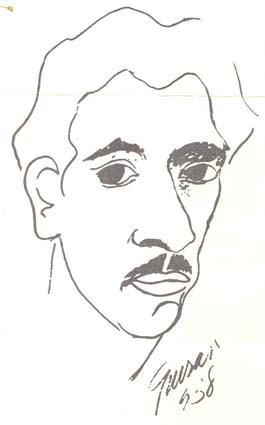4.1.1.18 The poetic work of Ramón Guirao (1908 – 1949)

Ramón Guirao’s foray into poetic creation was primarily associated with the field of black poetry; while he wasn’t among the cultivators who endowed this movement with a major aesthetic depth, he is recognized as its forerunner on the island, with some achievements that would be elevated to higher levels in the poetic register of Emilio Ballagas and Nicolás Guillén, the movement’s most important exponents.
The piece that opens the backstage of this lyrical trend on the Island is “Bailadora de rumba” – published in the Diario de la Marina in 1928 – in which most of the characteristic features of this poetic style with its delightful sensualist roots can be appreciated:
“Guaguancó dancer,
black skin,
bongo smoothness.
Shake the maraca of his laughter
with milk fingers
of his teeth.
White handkerchief
-silk-,
white coat
-starch-,
they travel the route
of a rope
in an Afro-Cuban rhythm
of
guitar
clue
and drawer
“Up, Maria Antonia,
“Praise be to God!”
The snakes on his arms
they are releasing the accounts
from a soap necklace.”
The poem is a reflection of the first exploratory glimpses into the other root of Cuban culture, although it remains, like the bulk of Guirao’s poetry, on a merely descriptive level. The leitmotif of dance and the swaying of the body already converge here through similes from the animal, the allusion to musical instruments and the attempt to somehow transmit a percussive musicality.
Ramón Guirao’s black sign poetic work extends approximately over the period of 8 years, as part of which he publishes his book “Bongó” in 1934 and culminates in 1936 with the verses of “Décimas” and “Sexteto” that he publishes in the magazine “Grafos”.
Throughout his career in Black poetry, he sometimes uses avant-garde techniques and prosodic distortions that attempt to mimic Black speech; however, he is less successful in this regard, but rather more successful in his reflection of moments of life in Black culture, like snapshots of a certain impressionism.
His later verses are somewhat influenced by purism but strongly influenced by romanticism, and are aesthetically pleasing, although they do not contain substantial contributions to national poetry. In 1944, he published the poem “Espejo de sueño” (Mirror of Dream) in the magazine “Orígenes,” whose title reflects its location in the nation’s poetic past. A fragment of this poem is transcribed below:
“You were close,
my breath, but what hidden hand
I closed my mouth, what anguish,
like a flower, it weighed on my chest!
Towards what eternal darkness he was heading
my steps. It was already a memory.
The awareness of having lived
fell asleep in my veins.
What remote passions moved
my lips, gave color, oblivion
to my memories…
I couldn’t say anything,
because I was unaware of that other landscape
sensitive to the eyes of the soul,
where the waters choose their path,
where the light works the miracle
of the form, and strips the roots…
He also displayed meritorious essay work, even winning the national essay award in 1937. He collaborated in numerous publications of the time, including: Revista de Avance, La Prensa, Orbe, Carteles, Revista de la Habana, Social, Línea, Confederación, Masas, Resumen, Revista Bimestre Cubana, Revista Cubana, Bohemia, Espuela de Plata, La Verónica, Verbum, Orígenes, Repertorio Americano (Costa Rica), among others. The most important aspect of his work was having been a pioneer in lyric poetry and essays in the vindication of black culture for the definitive face of the nation.








